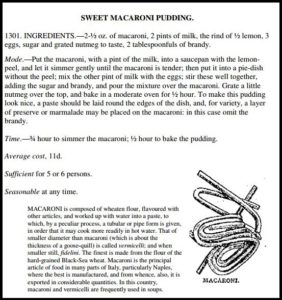As part of our historical recipe project, our Lab Manager Alexis Dunlop brought in sweet macaroni pudding!
The transition of pasta from a sweet to uniquely savoury ingredient provides a fascinating insight into how our tastes and expectations have changed over time.
[line]
In Anne Yentsch’s article Applying Concepts from Historical Archaeology to New England’s Nineteenth-Century Cookbooks, she notes a marked drop off post 1870 in the inclusion of pudding recipes that called for items we traditionally think of as savoury; such as potato, winter squash, and macaroni or vermicelli. Although there are a few places where sweet macaroni dishes carry on, most people think of it being exclusively for macaroni and cheese, cold pasta salads, and occasionally soups so I thought it would be interesting to try as a dessert item.
I made Sweet Macaroni Pudding from Mrs Beeton’s The Book of Household Management, published in 1861. Mrs Beeton’s cookbook was one of the first to include precise quantities and instructions for each recipe. Following the directions as faithfully as possible, the recipe was straightforward and easy to follow. The instruction of “sugar and nutmeg to taste” was subjective and I suspect that I didn’t sweeten it as much as my Victorian counterparts would have. As well, the recipe called for a “moderate oven”, which historical food experts interpret as approximately 350F. It’s worth noting our modern macaroni isn’t quite the same as that used by 19th century cooks; their macaroni was thinner and came in longer strands that were then broken down into smaller sections. In the case of both modern and historical pasta, 45 minutes of simmering in milk seemed like an excessive amount of time to cook pasta.
During the tasting at the office, the word that most people used when describing the finished product was “interesting”. The appearance and texture was very similar to a nice baked macaroni and cheese but the combination of nutmeg, brandy, milk, and egg base had an eggnog flavour to it. Having cooked the macaroni for the full time as proscribed by the recipe meant that it was very soft and the whole dish was rich and custardy. While not unpleasant, almost everyone commented that they were expecting a cheesy flavour when they took a bite. I went home with a sizeable amount of leftover pudding.
On the home front, I tried to give my preschooler daughter a scoop of this historical treat after dinner. She was very unimpressed that I was trying to feed her macaroni and cheese for dessert and refused to eat any more after trying one bite. She was polite but firm in her denial. In her 2.75 year old mind, like my adult colleagues, the associations between macaroni and savoury are too strong to entertain the notion of a sweet pasta dish.
While a fun experiment, I do not think I will be adding this into my regular recipe rotation.
Written by Alexis Dunlop
Mrs Beeton’s Sweet Macaroni Pudding
2-1/2 oz. of macaroni
2 pints of milk
the rind of 1/2 lemon
3 eggs
sugar and grated nutmeg to taste
2 tablespoonfuls of brandy.
Mode.—Put the macaroni, with a pint of the milk, into a saucepan with the lemon-peel, and let it simmer gently until the macaroni is tender; then put it into a pie-dish without the peel; mix the other pint of milk with the eggs; stir these well together, adding the sugar and brandy, and pour the mixture over the macaroni. Grate a little nutmeg over the top, and bake in a moderate oven for 1/2 hour. To make this pudding look nice, a paste should be laid round the edges of the dish, and, for variety, a layer of preserve or marmalade may be placed on the macaroni: in this case omit the brandy.
Time.—3/4 hour to simmer the macaroni; 1/2 hour to bake the pudding.
Average cost, 11d.
Sufficient for 5 or 6 persons.
Seasonable at any time.







